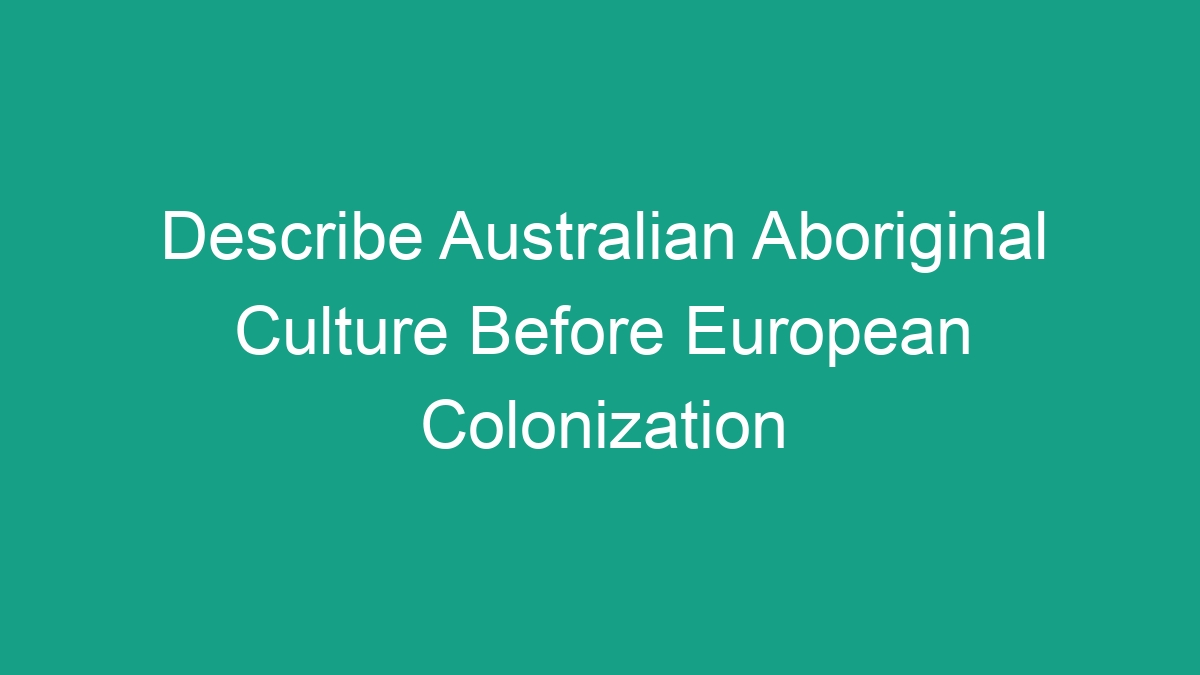
Australia is home to one of the oldest living cultures in the world, that of the Australian Aboriginal people. Before European colonization, which began in the late 18th century, the Aboriginal people had developed a rich and complex culture that was deeply connected to the land and the natural environment. In this article, we will delve into the various aspects of Australian Aboriginal culture before the arrival of the Europeans and explore the traditions, beliefs, and practices that shaped their way of life.
The Land and Connection to Country
One of the defining features of Australian Aboriginal culture is the deep spiritual connection to the land. The Aboriginal people believe that the land is their mother, providing them with everything they need to survive. This deep spiritual connection is evident in their stories, art, and ceremonies, which often revolve around the creation of the land and the ancestral spirits that shaped it.
The concept of “Country” is central to Aboriginal culture, with each group of people having their own Country that they are responsible for caring for. This connection to Country is passed down through generations, and the land holds immense cultural and spiritual significance for the Aboriginal people.
Social Structure and Kinship
Aboriginal societies were traditionally organized around kinship systems, which governed all aspects of social and familial relationships. Kinship was the foundation of Aboriginal social structure and dictated how people related to one another, their roles within the community, and their obligations to one another.
Aboriginal societies were often divided into clans or kinship groups, with each group having its own set of laws, traditions, and responsibilities. These kinship ties formed the basis of Aboriginal society and ensured that people had a strong support network within their community.
Art and Storytelling
Art and storytelling were integral to the preservation and communication of Aboriginal culture and traditions. Aboriginal art, including rock paintings, cave drawings, and ceremonial body paintings, often depicted stories of creation, ancestral spirits, and the Dreaming – the spiritual and cultural belief system of the Aboriginal people.
Storytelling was an essential tool for passing down knowledge, traditions, and cultural practices from one generation to the next. Elders and community leaders would share stories through oral traditions, ensuring that the knowledge of the past was not lost.
The Dreaming
The Dreaming, or “Tjukurrpa” in some Aboriginal languages, is a complex spiritual belief system that encompasses the creation of the world, the actions of ancestral beings, and the laws and customs that govern Aboriginal life. The Dreaming is not just a series of stories or myths, but a living, continuous spiritual and cultural landscape that connects the past, present, and future.
The Dreaming is central to Aboriginal identity, providing a framework for understanding the world, the land, and the connections between all living things. The Dreaming influences every aspect of Aboriginal life, from daily rituals and ceremonies to the connections between people, land, and animals.
Ceremonies and Rituals
Ceremonies and rituals played a significant role in the spiritual and cultural life of the Aboriginal people. These ceremonies were often tied to the land and the Dreaming, serving as a way to connect with ancestral spirits, ask for guidance, and pass down traditions to future generations.
Ceremonies varied among different Aboriginal groups and were often tied to specific events such as initiations, marriages, and seasonal changes. These rituals were highly symbolic and reflected the deep spiritual connection that the Aboriginal people had with the land and the natural environment.
Language and Communication
Aboriginal languages are incredibly diverse, with hundreds of distinct languages spoken across the continent before European colonization. Language was a fundamental aspect of Aboriginal culture, serving as a means of communication, preserving knowledge, and expressing cultural identity.
Aboriginal languages were intricately connected to the land, with many words and concepts directly related to the environment and the natural world. Language was also used to pass down stories, traditions, and cultural practices, ensuring that the richness of Aboriginal culture was preserved and shared.
Survival and Sustainable Living
Before European colonization, the Aboriginal people had developed a deep understanding of the natural environment and practiced sustainable living for thousands of years. Their knowledge of the land, plants, and animals allowed them to thrive in some of the harshest environments on Earth.
Aboriginal people were skilled hunters and gatherers, using a combination of hunting, fishing, and foraging to sustain themselves. They also practiced land management techniques such as controlled burning to maintain the health of the land and promote the growth of important food sources.
Conclusion
The richness and complexity of Australian Aboriginal culture before European colonization cannot be understated. The deep spiritual connection to the land, the intricate kinship systems, the importance of art and storytelling, the spiritual beliefs of the Dreaming, and the sustainable living practices all contributed to a culture that was deeply rooted in the land and the natural environment.
Understanding and respecting the traditions and beliefs of Australian Aboriginal culture is crucial in recognizing the significance of their heritage and the ongoing contributions they make to society. By preserving and celebrating this ancient culture, we honor the resilience and enduring spirit of the world’s oldest living culture.



